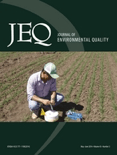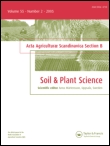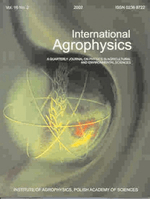
Transactions of the ASABE
Scope & Guideline
Innovating practices for a resilient agricultural future.
Introduction
Aims and Scopes
- Agricultural Engineering Innovations:
The journal emphasizes research on advanced engineering techniques and technologies that improve agricultural productivity and sustainability. This includes the development of new machinery, tools, and systems that enhance farm operations. - Water Management and Irrigation:
A significant focus is placed on water resource management, including irrigation strategies, water quality, and the effects of agricultural practices on hydrology. This includes modeling and simulation studies aimed at optimizing water use in agriculture. - Soil and Crop Management:
Research on soil health, fertility, and crop management techniques is a core area. This encompasses studies on nutrient management, soil erosion control, and innovative agricultural practices that enhance crop yield and quality. - Environmental Impact and Sustainability:
The journal addresses environmental issues related to agriculture, such as greenhouse gas emissions, waste management, and sustainable farming practices. Research aimed at reducing the ecological footprint of agricultural activities is prioritized. - Precision Agriculture and Technological Integration:
The integration of precision agriculture technologies, including remote sensing, UAVs, and data analytics, is a key area of focus. Studies on the application of these technologies for enhanced decision-making in farming are frequently published.
Trending and Emerging
- Robotic and Automation Technologies:
The development and application of robotics in agriculture are increasingly highlighted, reflecting a trend towards automation in tasks such as harvesting, planting, and monitoring crops. This is crucial for addressing labor shortages and improving efficiency. - Data-Driven Agriculture and Machine Learning:
There is a growing emphasis on the use of big data, machine learning, and AI to analyze agricultural systems. This trend is significant for enhancing precision agriculture practices and improving decision-making processes. - Sustainable Waste Management Practices:
Research focusing on sustainable management of agricultural waste, including manure and crop residues, is gaining importance. This includes studies on bioconversion technologies and nutrient recycling to minimize environmental impact. - Climate Resilience in Agriculture:
Emerging studies are increasingly addressing climate adaptation strategies for agriculture, including the impacts of climate change on crop yields and water availability. This theme is vital for developing resilient agricultural systems. - Integrated Pest Management Strategies:
Research on innovative pest management techniques that integrate biological control, precision application, and environmental considerations is trending. This reflects a shift towards more sustainable and effective pest control methods.
Declining or Waning
- Traditional Agricultural Practices:
Research focusing solely on conventional agricultural practices has diminished, as the field moves towards more innovative, technology-driven solutions. There is a noticeable shift towards precision farming and sustainable practices. - Basic Agricultural Chemistry:
While still relevant, studies centered solely on fundamental chemical analyses of agricultural inputs are less frequent, as multidisciplinary approaches that incorporate biological, environmental, and engineering perspectives gain prominence. - Static Crop Modeling:
Models that do not incorporate dynamic environmental interactions or real-time data are becoming less common. Researchers are increasingly adopting more complex, adaptive modeling techniques that account for variability in agricultural systems. - Generalized Environmental Assessments:
Broad studies assessing environmental impacts without specific agricultural contexts are declining. There is a trend towards focused assessments that link specific practices with measurable environmental outcomes. - Low-Tech Solutions:
Research on low-tech or traditional farming solutions is seeing reduced publication frequency, as the journal increasingly favors innovative, technology-based approaches that promise higher efficiency and sustainability.
Similar Journals

Engenharia Agricola
Bridging knowledge and practice in agricultural sciences.Engenharia Agricola, published by the SOC BRASIL ENGENHARIA AGRICOLA, is a crucial open-access journal that has been at the forefront of agricultural engineering research since its inception in 1981. With an E-ISSN of 1809-4430 and an ISSN of 0100-6916, this journal stands out in the field by providing a platform for disseminating innovative studies and advancements in agricultural practices and technologies. Based in Brazil, the journal emphasizes global perspectives in agricultural and biological sciences, currently positioned in the Q3 quartile of its category, as recognized in the 2023 Scopus Ranks, where it ranks 97 out of 193 publications. Researchers, professionals, and students can access a plethora of high-quality articles that contribute to sustainable agronomy, agricultural mechanics, and resource efficiency across various environments, with open access since 2004, ensuring that critical knowledge is readily available to all stakeholders in the field.

JOURNAL OF ENVIRONMENTAL QUALITY
Shaping the Future of Environmental Quality Through Rigorous ResearchJOURNAL OF ENVIRONMENTAL QUALITY, published by Wiley, is a premier academic journal in the field of environmental science, dedicated to advancing knowledge in areas such as environmental engineering, waste management, water science, and pollution control. With an ISSN of 0047-2425 and an E-ISSN of 1537-2537, this esteemed journal is recognized for its rigorous peer-review process and impactful research contributions, reflected in its Q2 category rankings across multiple subfields as of 2023, including a notable rank of #57 in Waste Management and Disposal. The journal serves as a vital platform for researchers, professionals, and students aiming to address contemporary environmental challenges through innovative solutions and policies. Covering a history of over five decades, from 1972 to 2024, the JOURNAL OF ENVIRONMENTAL QUALITY continues to be an essential resource for high-quality research and discourse in the pursuit of a sustainable environment.

International Journal of Plant Production
Advancing sustainable agriculture through innovative research.International Journal of Plant Production, published by SPRINGER in Switzerland, serves as a leading platform for the dissemination of innovative research in the fields of Agronomy, Crop Science, and Plant Science. With an ISSN of 1735-6814 and an E-ISSN of 1735-8043, this journal has maintained its reputation by achieving a Q2 quartile ranking in both categories as of 2023, alongside notable Scopus rankings placing it in the top quartiles of its fields (Rank #105/516 and Rank #88/406, respectively). The journal's scope encompasses a wide array of topics vital to sustainable agriculture and plant production systems, making it a critical resource for researchers, professionals, and students striving for advancements in these disciplines. By fostering open scientific dialogue and supporting cutting-edge research, the International Journal of Plant Production is committed to contributing to the resolution of global food security challenges, enhancing agricultural practices, and promoting ecological sustainability.

Journal of Tekirdag Agriculture Faculty-Tekirdag Ziraat Fakultesi Dergisi
Transforming challenges into solutions for a sustainable future.The Journal of Tekirdag Agriculture Faculty-Tekirdag Ziraat Fakultesi Dergisi, published by UNIV NAMIK KEMAL, represents a significant platform dedicated to the dissemination of research in the fields of agricultural and biological sciences. With an ISSN of 1302-7050 and E-ISSN 2146-5894, this journal aims to advance knowledge and innovation within its scope, which encompasses a diverse array of agricultural topics and environmental pollution. Notably, it has achieved a Q3 category ranking in Agricultural and Biological Sciences and a Q4 category ranking in Pollution for 2023, reflecting its growing influence in the academic community. Operating from Turkey, the journal publishes articles that seek to address contemporary challenges in agriculture and environmental science, thus fostering collaborations among researchers, professionals, and students worldwide. Researchers can benefit from the journal’s focus on applied sciences, providing insights and solutions pertinent to real-world issues. Engage with cutting-edge studies and contribute to this evolving field by exploring the transformative research featured within.

ACTA AGRICULTURAE SCANDINAVICA SECTION B-SOIL AND PLANT SCIENCE
Exploring the Interactions of Soil and Crop for a Greener TomorrowACTA AGRICULTURAE SCANDINAVICA SECTION B-SOIL AND PLANT SCIENCE, published by Taylor & Francis AS, is a distinguished journal dedicated to the fields of Agronomy, Crop Science, and Soil Science. With an impressive impact factor, and categorized in Q2 for both Agronomy and Crop Science and Soil Science as of 2023, this journal is an essential resource for researchers, professionals, and students aiming to advance their understanding of soil-plant interactions and sustainable agricultural practices. Operating since 1992 and continuing through to 2024, ACTA aims to publish high-quality, peer-reviewed research that encourages the applicability of advanced scientific knowledge in real-world agricultural settings. While the journal is not open access, it remains widely accessible through institutional subscriptions, reflecting its commitment to disseminating essential findings and fostering innovation in soil and plant science worldwide. Nestled in the vibrant academic environment of Norway, ACTA AGRICULTURAE SCANDINAVICA serves as a key platform for nurturing groundbreaking research that informs sustainable agricultural policies and practices globally.

AGROCIENCIA
Fostering collaboration to transform agricultural practices.AGROCIENCIA, published by COLEGIO POSTGRADUADOS, is a key journal in the fields of agronomy, animal science, and environmental science in Mexico. With an ISSN of 1405-3195 and an E-ISSN of 2521-9766, this journal has been a crucial platform for disseminating research findings since its inception in 2000. Operating from Montecillo, Estado Mexico, it provides an outlet for scholars and practitioners to share innovations and insights that directly impact agricultural practices and environmental sustainability. Despite its current categorization in the Q4 quartile across multiple disciplines, AGROCIENCIA strives to elevate the quality and reach of research, fostering a collaborative approach to tackle pressing issues within the agricultural sciences. Access options are primarily through institutional subscriptions, allowing for a diverse audience of researchers, professionals, and students to engage with the latest studies aimed at advancing knowledge in the agricultural sector. As the journal converges towards its 2024 milestone, it remains dedicated to enhancing scientific inquiry and promoting effective solutions within its discipline.

AGRONOMIA MESOAMERICANA
Inspiring change through cutting-edge agricultural research.AGRONOMIA MESOAMERICANA is a distinguished open-access journal published by UNIV COSTA RICA, dedicated to advancing knowledge in the fields of agronomy, crop science, food science, and soil science. Since its inception in 1990, the journal has provided a platform for researchers and professionals to disseminate their findings, contributing significantly to the agricultural sciences. With an E-ISSN of 2215-3608, it operates from Costa Rica, specifically from the Centro Investigaciones Agronómicas, situated in San José. Despite its current classification in the Q4 quartile for 2023 in the respective fields, it aims to stimulate academic discourse and inspire innovative solutions to pressing agricultural challenges. The journal attracts a diverse audience and encourages submissions that focus on sustainable practices, food security, and environmental stewardship, making it an essential resource for researchers, professionals, and students alike seeking to enrich their understanding and share crucial insights in the agronomy landscape. Open access ensures that all published research is freely available, fostering collaboration and knowledge exchange worldwide.

Revista Ciencia Agronomica
Connecting research and practice in agricultural sciences.Revista Ciencia Agronomica is a leading open access journal published by the Universidade Federal do Ceará, Departamento de Geociências, dedicated to advancing the field of agricultural sciences. Established in 2008, the journal has emerged as a significant platform for the dissemination of original research and innovative advancements in areas including agronomy, horticulture, and soil science, with a dedicated convergence of years extending to 2025. With an impactful presence in academic circles—ranking in Q3 for Agronomy and Crop Science and Soil Science and Q2 for Horticulture in 2023—this journal provides vital insights for researchers and practitioners alike. Although specific HIndex metrics are currently unavailable, the journal's Scopus rankings attest to its relevance, placing it in the 52nd, 44th, and 43rd percentiles across multiple pertinent categories. Since transitioning to an open access model in 2010, Revista Ciencia Agronomica has committed to maximizing the reach and impact of its published work, thereby ensuring valuable contributions to global agricultural knowledge.

International Agrophysics
Advancing interdisciplinary research for sustainable agriculture.International Agrophysics is a prestigious open-access journal published by the Polish Academy of Sciences, Institute of Agrophysics. Since its inception in 1989, the journal has provided a vital platform for disseminating innovative research across various domains, primarily focusing on Agricultural and Biological Sciences, Fluid Flow and Transfer Processes, and Soil Science, garnering a commendable Q2 ranking in several of these fields as of 2023. The journal's commitment to open access since 2012 underscores its mission to enhance the visibility and accessibility of scientific knowledge, benefiting not only researchers and professionals but also students who seek to further their understanding of these essential disciplines. With an emphasis on interdisciplinary approaches, International Agrophysics invites cutting-edge research that addresses contemporary challenges within the agricultural and environmental sectors. As a key resource for impactful studies, the journal plays a crucial role in fostering collaboration among scientists and policymakers, ultimately contributing to sustainable agricultural practices and environmental resilience.

Paddy and Water Environment
Exploring the synergy between agriculture and environmental preservation.Paddy and Water Environment is a pivotal journal published by Springer Heidelberg, dedicated to advancing the fields of Agronomy, Environmental Engineering, and Water Science and Technology. Established in 2005, this esteemed journal focuses on the complex interactions between paddy cultivation and water management, addressing critical issues related to sustainable agriculture and environmental preservation. With an impressive performance in Scopus rankings—holding Q2 positions across multiple categories and showcasing a commendable publication impact—this journal serves as an essential resource for researchers, professionals, and students alike. Paddy and Water Environment provides insightful research articles, reviews, and case studies that contribute to the understanding of the intricate relationships between the environment and agricultural practices, promoting strategies for sustainable development. Subscribers benefit from access to a wealth of knowledge, underscoring the journal's significance in fostering scientific inquiry and innovation within its domain.